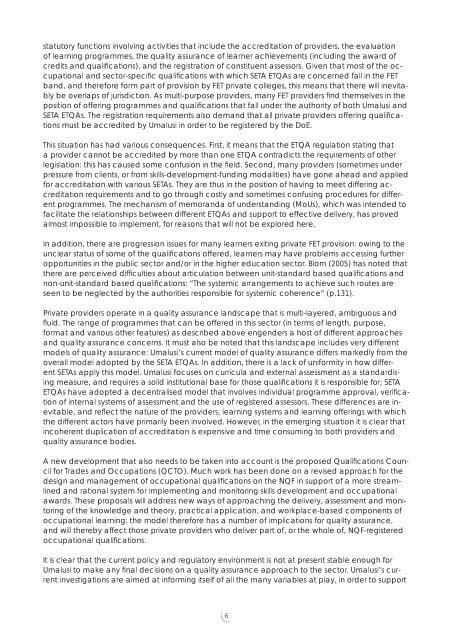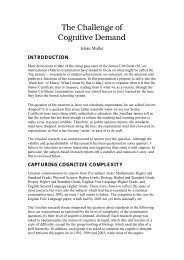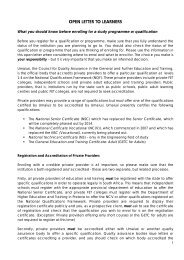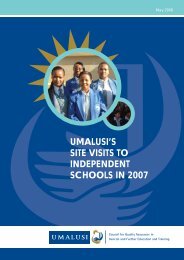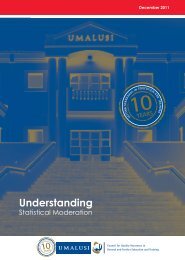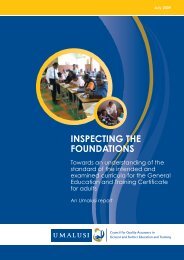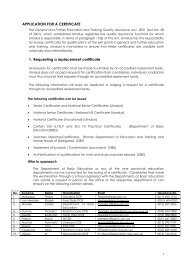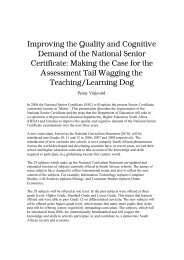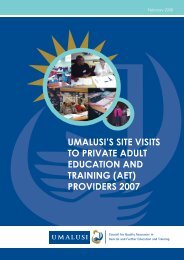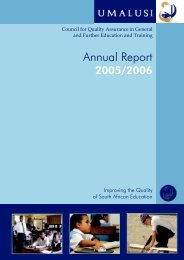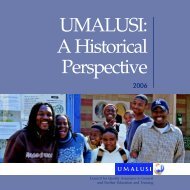fet private providers site visit and verification report - Umalusi
fet private providers site visit and verification report - Umalusi
fet private providers site visit and verification report - Umalusi
Create successful ePaper yourself
Turn your PDF publications into a flip-book with our unique Google optimized e-Paper software.
statutory functions involving activities that include the accreditation of <strong>providers</strong>, the evaluationof learning programmes, the quality assurance of learner achievements (including the award ofcredits <strong>and</strong> qualifi cations), <strong>and</strong> the registration of constituent assessors. Given that most of the occupational<strong>and</strong> sector-specifi c qualifi cations with which SETA ETQAs are concerned fall in the FETb<strong>and</strong>, <strong>and</strong> therefore form part of provision by FET <strong>private</strong> colleges, this means that there will inevitablybe overlaps of jurisdiction. As multi-purpose <strong>providers</strong>, many FET <strong>providers</strong> fi nd themselves in theposition of offering programmes <strong>and</strong> qualifi cations that fall under the authority of both <strong>Umalusi</strong> <strong>and</strong>SETA ETQAs. The registration requirements also dem<strong>and</strong> that all <strong>private</strong> <strong>providers</strong> offering qualifi cationsmust be accredited by <strong>Umalusi</strong> in order to be registered by the DoE.This situation has had various consequences. First, it means that the ETQA regulation stating thata provider cannot be accredited by more than one ETQA contradicts the requirements of otherlegislation: this has caused some confusion in the fi eld. Second, many <strong>providers</strong> (sometimes underpressure from clients, or from skills-development-funding modalities) have gone ahead <strong>and</strong> appliedfor accreditation with various SETAs. They are thus in the position of having to meet differing accreditationrequirements <strong>and</strong> to go through costly <strong>and</strong> sometimes confusing procedures for differentprogrammes. The mechanism of memor<strong>and</strong>a of underst<strong>and</strong>ing (MoUs), which was intended tofacilitate the relationships between different ETQAs <strong>and</strong> support to effective delivery, has provedalmost impossible to implement, for reasons that will not be explored here.In addition, there are progression issues for many learners exiting <strong>private</strong> FET provision: owing to theunclear status of some of the qualifi cations offered, learners may have problems accessing furtheropportunities in the public sector <strong>and</strong>/or in the higher education sector. Blom (2005) has noted thatthere are perceived diffi culties about articulation between unit-st<strong>and</strong>ard based qualifi cations <strong>and</strong>non-unit-st<strong>and</strong>ard based qualifi cations: “The systemic arrangements to achieve such routes areseen to be neglected by the authorities responsible for systemic coherence” (p.131).Private <strong>providers</strong> operate in a quality assurance l<strong>and</strong>scape that is multi-layered, ambiguous <strong>and</strong>fl uid. The range of programmes that can be offered in this sector (in terms of length, purpose,format <strong>and</strong> various other features) as described above engenders a host of different approaches<strong>and</strong> quality assurance concerns. It must also be noted that this l<strong>and</strong>scape includes very differentmodels of quality assurance: <strong>Umalusi</strong>’s current model of quality assurance differs markedly from theoverall model adopted by the SETA ETQAs. In addition, there is a lack of uniformity in how differentSETAs apply this model. <strong>Umalusi</strong> focuses on curricula <strong>and</strong> external assessment as a st<strong>and</strong>ardisingmeasure, <strong>and</strong> requires a solid institutional base for those qualifi cations it is responsible for; SETAETQAs have adopted a decentralised model that involves individual programme approval, verifi cationof internal systems of assessment <strong>and</strong> the use of registered assessors. These differences are inevitable,<strong>and</strong> refl ect the nature of the <strong>providers</strong>, learning systems <strong>and</strong> learning offerings with whichthe different actors have primarily been involved. However, in the emerging situation it is clear thatincoherent duplication of accreditation is expensive <strong>and</strong> time consuming to both <strong>providers</strong> <strong>and</strong>quality assurance bodies.A new development that also needs to be taken into account is the proposed Qualifi cations Councilfor Trades <strong>and</strong> Occupations (QCTO). Much work has been done on a revised approach for thedesign <strong>and</strong> management of occupational qualifi cations on the NQF in support of a more streamlined<strong>and</strong> rational system for implementing <strong>and</strong> monitoring skills development <strong>and</strong> occupationalawards. These proposals will address new ways of approaching the delivery, assessment <strong>and</strong> monitoringof the knowledge <strong>and</strong> theory, practical application, <strong>and</strong> workplace-based components ofoccupational learning: the model therefore has a number of implications for quality assurance,<strong>and</strong> will thereby affect those <strong>private</strong> <strong>providers</strong> who deliver part of, or the whole of, NQF-registeredoccupational qualifi cations.It is clear that the current policy <strong>and</strong> regulatory environment is not at present stable enough for<strong>Umalusi</strong> to make any fi nal decisions on a quality assurance approach to the sector. <strong>Umalusi</strong>’s currentinvestigations are aimed at informing itself of all the many variables at play, in order to support6


